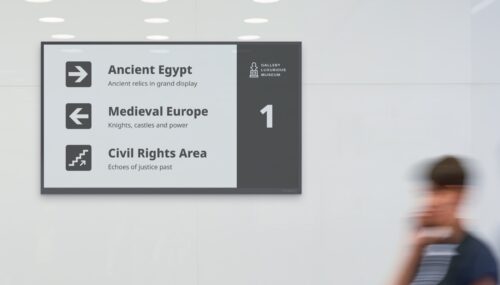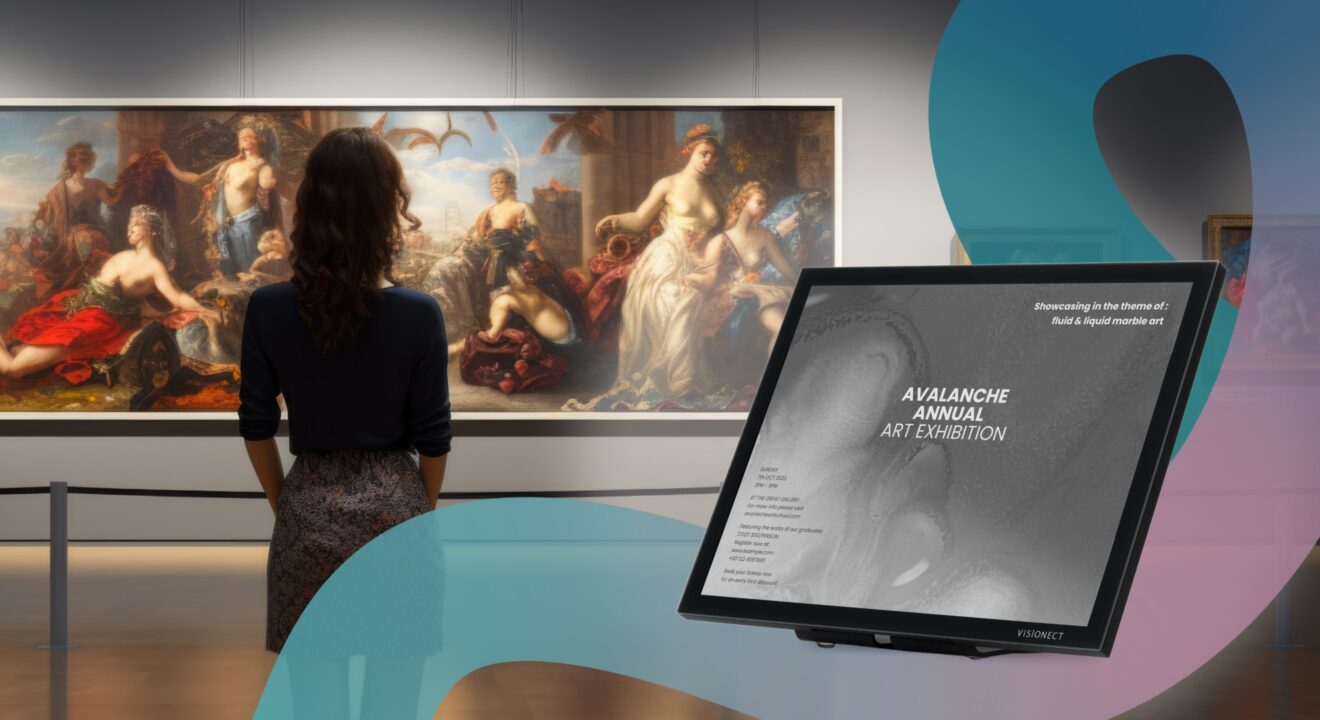

Digital signage for Museums: Use cases and best practices
Visionect, 17 Jun 2025
Digital signage helps museums to evolve from static displays into dynamic, interactive spaces. The technology improves how museums share information, guide visitors, and create memorable experiences. In this guide, we’ll explore practical digital signage use cases for museums.
Museum digital signage use cases
Digital signage can support every part of the museum journey, from welcoming guests to sharing artist bios. Below are key ways museums use digital displays to improve engagement, navigation, and storytelling.
Lobby information signage
Digital lobby signage acts as the museum’s first impression by showcasing up-to-date hours, ticketing details, and visitor guidelines in an eye-catching format. This real-time display ensures guests are informed and prepared before they begin their journey, making it a vital part of any museum digital signage strategy.

Wayfinding and directions
Interactive wayfinding kiosks and directional displays guide visitors through complex museum layouts, helping them quickly locate exhibitions, facilities, and exits. These dynamic maps can be updated in real time to reflect exhibit updates, events, or workflow changes.
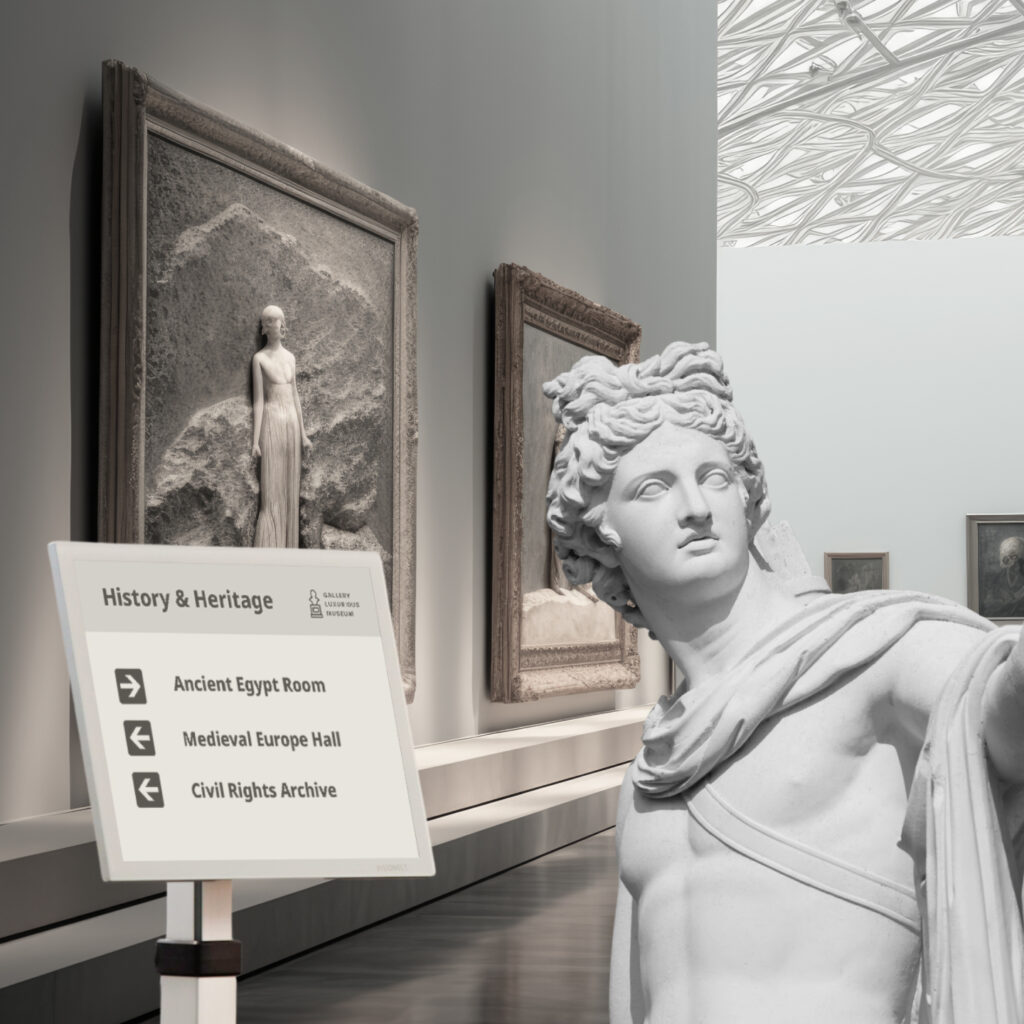
Promoting events
Strategically placed digital screens promote lectures, workshops, and special exhibits with vibrant visuals that drive attendance. Real-time scheduling and ticketing information keep guests engaged and informed throughout their visit.
Sharing social content
Social media walls display live Instagram or Twitter feeds featuring user-generated hashtag content, amplifying community engagement and boosting the museum’s digital presence. Showcasing reviewed posts invites interaction and encourages visitors to share their own moments onsite.
Interactive touch screen kiosks
Touchscreen kiosks empower visitors to dive deeper into exhibits, exploring multimedia content, interactive timelines, and scavenger-hunt style experiences at their own pace. This self-guided interaction not only entertains but can also provide analytics on visitor preferences.
Exhibit information
Digital exhibit labels can present multimedia-enhanced content like videos, animations, and context-rich text directly alongside displays, unlocking deeper understanding of artifacts. These screens can easily support multilingual descriptions and accessibility features for diverse audiences.
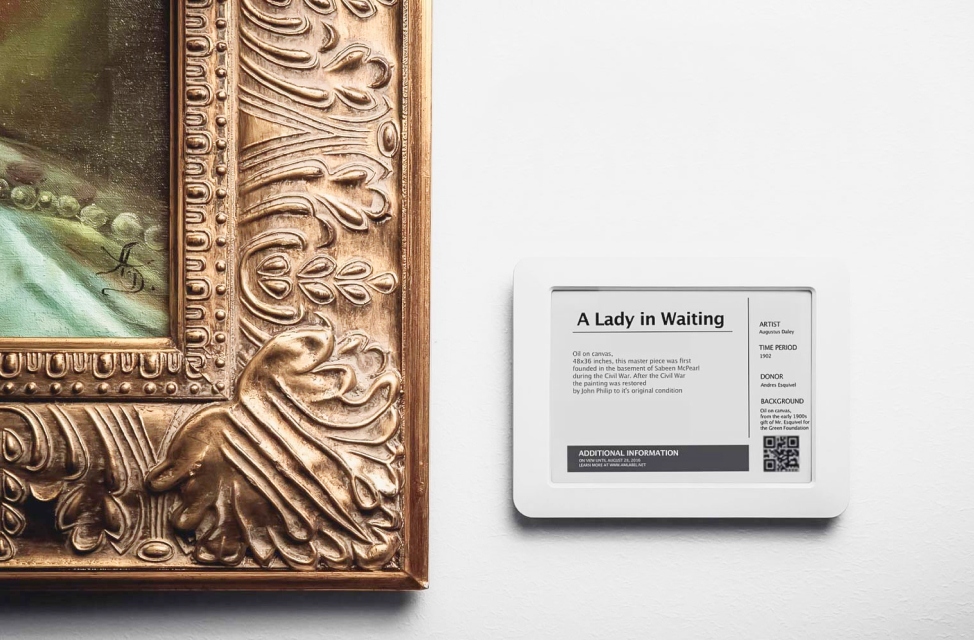
Artist bios
Artist-focused displays highlight creator biographies, interviews, and behind-the-scenes visuals, giving visitors a more personal connection to the art. These digital showcases allow easy updates to content and support deeper narratives without crowding physical space.
Wall of graphics (digital tiles)
Large-scale HD wall installations or tiled display arrays create striking visuals, telling immersive stories through mosaics of changing imagery. This flexible layout mimics curated murals, offering an impactful backdrop for exhibitions and multi-screen graphics.
Sponsors awareness
Digital displays are great for sharing sponsor acknowledgments and rotating donor acknowledgments. Displaying sponsor details helps raise brand awareness and is a meaningful way for the museum to give back to those who support it.
Membership details and benefits display
Digital signage can showcase membership tiers, perks, renewal dates, and exclusive events in real time at entrances or kiosks, making it easy for visitors to understand what each membership includes. Remote updates keep content fresh and enticing, encouraging sign-ups and renewals.
Shop promotions and gift shop highlights
Digital signage in museum shops highlights exclusive merchandise, limited-time offers, and themed collections, encouraging impulse buys and upselling. Strategically placed screens boost revenue and allow instant updates without reprinting signage.
Explore digital signage use cases from around the world.
How to integrate digital signage in museums
Museums and e-paper are like tea and biscuits — comforting yet refreshingly modern. In an age where every screen seems to scream for attention, e-paper whispers. Unlike backlit LED displays, Visionect’s ultra-low-power e-paper screens blend seamlessly into curated environments and remain readable in any lighting.
This quiet, low-power technology doesn’t just enhance the visitor experience — it’s also remarkably easy to integrate. Here’s how to get started with digital signage in your museum:
Setting up e-paper signage is as simple as “Place & Play”:
- Choose from a range of wireless E-Ink displays, from small room labels to large-format information boards.
- Mount the screens on walls, pedestals, or freestanding kiosks without requiring any cabling or wiring.
- Connect via Wi-Fi using Visionect’s intuitive management platform or integrate with your preferred CMS (like Easescreen or ScreenCloud).
Learn how to connect your CMS to your digital signage.
E-paper displays run on minimal power (often solar or battery) and are ideal for:
- Exhibit information
- Wayfinding
- Real-time announcements
- Multilingual visitor guidance
With the right CMS, you can even integrate your e-paper displays with other screen types across your museum for a hybrid signage network.
EXPLORE THE VISIONECT E-PAPER DISPLAY CATALOGUEMuseum digital signage showcase
Digital signage helps museums share real-time information, guide visitors, and create interactive experiences without disrupting the flow of discovery. From exhibit enhancements to event promotions, digital displays keep museums engaging, efficient, and visitor-focused.
Here are three examples of digital signage in action:
1. Leicester Museum and Art Gallery (visitor-curated labels)
In Leicester Museum and Art Gallery, interactive digital labels allow guests to share short, personal reflections directly next to artworks. Managed through a web‑based platform, the labels are updated in real time, fostering a dialogue between visitors and collections.
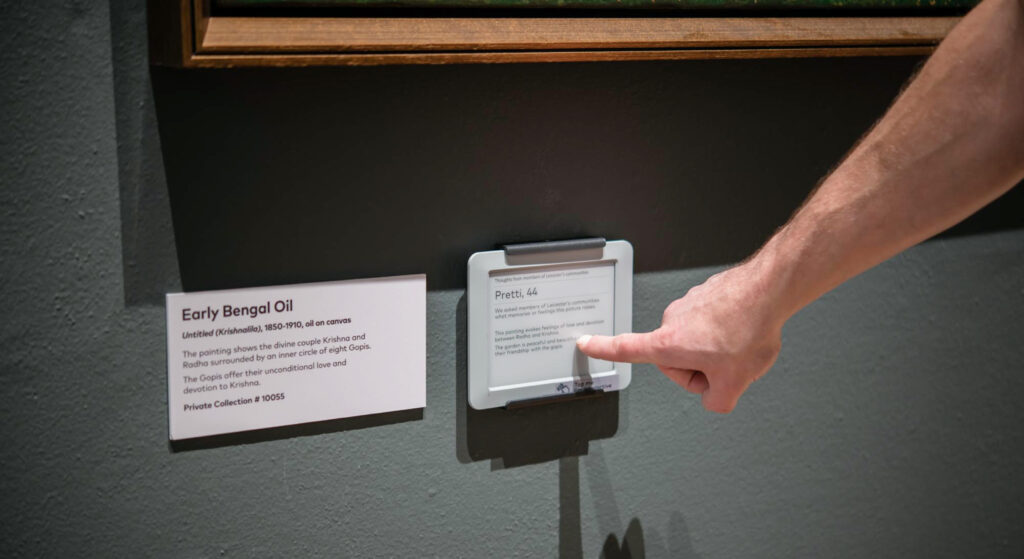
2. Amlabel Digital Gallery (cost‑efficient, real‑time labels)
The AMLABEL Digital Gallery modernized museum labeling by replacing paper cards with editable digital displays. These labels supported instant remote updates with cordless and drill‑free installation, cutting printing costs of $70–$100 per label. Exhibits remained current, multi‑language accessible, and easy on both staff time and the museum budget.

Bring Your Museum to Life with Digital Signage
Digital signage can do a lot for museums — from greeting visitors with fresh info in the lobby and helping them find their way around, to adding rich multimedia to exhibits and even letting guests share their own thoughts. It’s all about making the visit more engaging and easy to navigate.
If you’re looking for a solution that feels natural and doesn’t get in the way, e-paper screens are a great fit. These subtle digital displays help museums keep stories alive and visitors connected without losing that special museum atmosphere.
Ready to take your museum to the next step? Let’s create something unforgettable together.
GET IN TOUCH TODAYTags

